By Dr Christina MacRae - Manchester Metropolitan University
(The original PREZI version of this presentation can be seen at the following link:http://prezi.com/gvwhajgmuqi9/art-practice-as-research-shifting-paradigms-in-documentation-practices/)
I began my career as an early years teacher, and then, I later became an education researcher focussing on the early years, and most recently I have also become an artist. Instead of seeing these identities as separate ones that I choose between, what I’d like to do is to think through ways in which these roles might begin to work together in order to generate a hybrid practice.
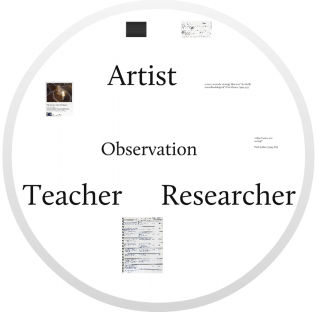
It was when I did my doctoral research I became very aware of all these different identities pulling me in different directions. This came out most strongly and specifically through the method of observation. While observation was a practice common to all three identities, it was performed differently according to which role I was working from. After 16 years of teaching, in my new position as a researcher, I found I had time to critically reflect on the check-list and the gridlines of the assessment boxes that I had been trained to use. I found myself returning to my teacher training where I was taught to observe using what was called the Target Child Observation Schedule.
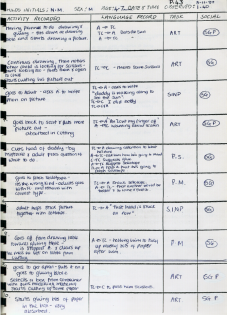
Being the collector that I am, I actually still had these records gathering dust in the attic... this is one of my observation sheets from twenty years ago - you won’t be able to read my notes, but what’s important for me now, is looking at how as an object it has certain effects.
I began to remember the difficulties that I had had as a trainee teacher trying to keep my observation within the gridded lines of the schedule, and how I had had to ‘tidy’ up my observations when submitting them for my assessment by altering my original notes to fit them into categories, even if I was not quite sure where I should put them. There was no room for uncertainty, every observation had its specific time and place, and yet in practice these observations were dogged by failure. I found I didn’t have time to write everything I saw; I found that my seeing was continually interrupted by my frantic scribbling as I made notes; I found myself distracted by the out of field world.
The finished sheets might have looked tidy, but they covered over a subtext of ongoing failure to observe procedurally and with accuracy. The very complexity of lived experience defied orders and categories. It was these failures that were all too easily overlooked in my efforts to be a good teacher.
As a researcher, drawing on ethnographic methods, I found a new distance from which to recognise that whilst classifying and categorising may inform us about child outcomes and contribute to what Gunnar Dahlberg calls "a discourse of quality" we must not forget the effects that this has on the way we create knowledge about the child. My attention was now drawn away from the children and towards the way we see children through particular framing devices and how that in turn produce particular discourses around the child.
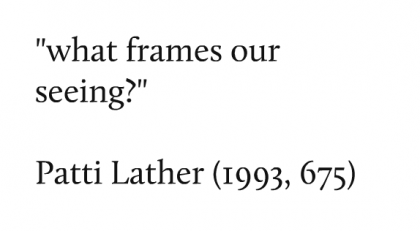
Rather than looking harder or more closely, Patti Lather urges us to look at "what frames our seeing" and become aware of the "spaces of constructed visibility" that produce relations of power and knowledge. The observer, by turning events into text, produces data that has been cut off from the "communication of people".

I began to experiment and adopt what was a "decidedly unmethodological" approach to data collection and I began to see my field notes, conversations, images and models produced by children, and photographs, ALL as artefacts of documentation produced in a continually expanding and unfolding field. I began to turn my attention away from the frames through which we view children and towards the artefactual documentation generated through encounters.
Data whose original function was to represent the field, became an object to be looked at, not to confirm what was already there, but to bring to the surface un-thought connections.
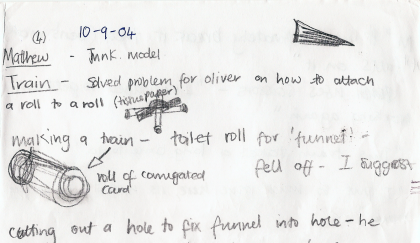
This is a field note from my phd research, where instead of procedural observations, I scribble impressions of what I observe in both words and pictures.
Looking back on these notes after the event allowed me to focus on the way that children engaged with objects and materials in new ways. I found that through them I could attend to small details missed previously, or things that now became visible and important because of new connections and understandings.
At the same time as becoming a researcher I was also attending art school. This emerging art practice, in turn also contaminated by my research approaches, where I started to turn to art theory as a way to think again about research methods. But, I felt frustrated that my art practice was over shadowed by my role as a researcher. I began to formulate a practice-led artist residency where I could explore how I could engage as an artist in an Early Years setting.
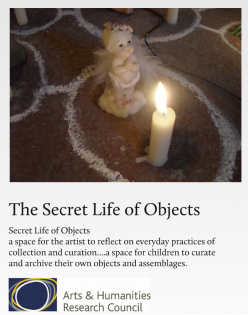
My six month residency, called the "Secret Life of Objects" was a funded by a practice-led small grant from the Arts and Humanities Research Council in 2009-2010. It set out to explore how my art practice could be developed by working alongside young children in the workshop environment of an early years classroom. My current practice involves collecting souvenirs, ornaments and other personal items from flea markets and second hand shops. During the residency I approached the child as both artist and collector in their own right by closely observing how they interacted with objects from my collection, as well as attending to their own collections and special objects.
During the research project, the medium of film, both still and moving helped to draw attention to children’s making process’s. Short pieces of film documented children’s hands as they arranged and re-arranged collected objects. This was a process that sometimes also contained shifting narrative threads, and these were shared on a residency blog. Rather than seeing the artist as the creative expert, the project tried to develop a methodology where I could develop my practice by engaging with practices encountered while working alongside young children. Here is a page from my sketchbook where I used notes taken at the time to reflect on an image:

this then provokes a reflection on the material qualities of objects as well as our bodily responses to them.
The residency was very productive in terms of the opportunities it gave me to develop my thinking around collecting and the relationships we make with objects during our daily life. It also produced relationships with children where I was deeply engaged in their practices and in what Carla Rinaldi calls a "pedagogy of listening" (2001: 80). This deep level of listening was something that I struggled to achieve as either a researcher or a teacher. The potential for this deep listening was in part produced through my interest in the everyday, and in relationships between objects and people.
In part it was possible because of my marginal position as an artist who could operate outside the tightly organized and planned structure of school.
In one sense I was acutely aware of my ‘useless-ness’ in the classroom, and yet on the other it was precisely this lack of obvious purpose and ambiguity that gave me time to listen to children and my genuine interest in their objects meant they had an interested other person to hear them. My redundancy was productive in terms of my relationships with the children, but I did not manage to harness it in order to create a space of dialogue with the practitioners.
Up until now I have talked about the artist teacher and researcher as separate things, now I want to think about ways to bring them together, and I will argue that documentation is central to this, in contrast to observation which characterised teaching, research and art practice.
I am just coming to the end of a Creative Partnership funded project working with two Sure Start Centres. While I feel the short-term nature of the project has been problematic (only 16 half days in each centre) I saw it as an opportunity to try to integrate my researcher self, with my teacher self and my artist self. Also I was asked by practice ie to guest edit their website over the last two months, which I also saw as an opportunity to explore ways of integrating these identities
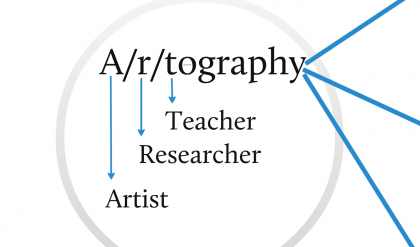
I am now trying use the practice/theory from an arts based movement that comes from Canada called a/r/tography. What I want to do is to pick out some of the key ideas that I find useful in this approach, so I can use them to think how they become helpful with the work I’m doing at the moment.
"Drawing attention to a/r/t (artist/researcher/teacher) isn’t intended to single one identity out, but rather it’s an encounter between bodies that releases something form each" (Springgay 2008; 159) At the heart is the practice of documentation rather than observation.
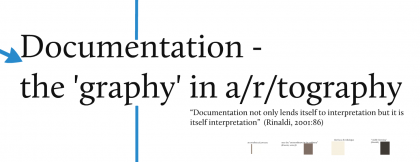
Documentation is the ‘graphy’ of a/r/tography: it not only lends itself to interpretation but it is itself interpretation
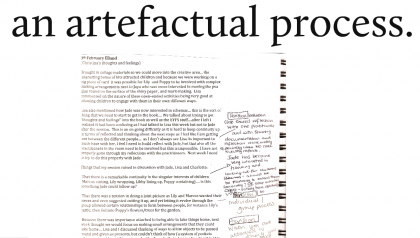
It is an artefactual process. (the examples of doc. Here are taken from my current sketchbook)
As artefact it is has a material and physical presence, one that can therefore continually be returned to be re-read. At the same time as bearing the trace of the event that it records, it also carries the trace of the person who made that recording. It does not represent an event, as it is both constructed, and at the same time, is itself of the event. It is in the documenting that a space is created that has the potential to be reflective and creative.
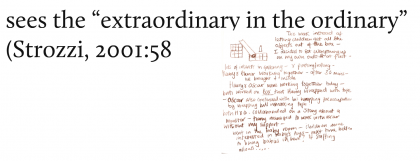
Documentation can be a way of heightening awareness of everyday moments; to see the "extraordinary in the ordinary" (Strozzi, 2001:58). Documentation is slow work; but it should not be solitary, it is about living together even if this takes more time.
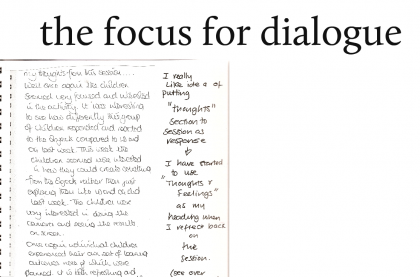
When I carried out my artist residency, in my sketchbooks I used photographs as memory traces in order to provoke my thinking around objects. They helped me to see differently but I was not using them as a space of dialogue with other practitioners, they were part of an internal dialogue, occupying a space between myself, the objects, and the children. Where as in this current sketchbook there is a dialogue between the practitioners and myself as they share their reflections with me.
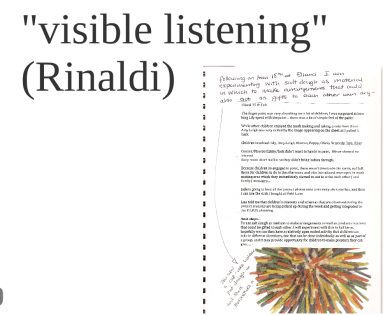
so in my current project I am using documentation as the focus for dialogue with practitioners as well as with children to create a form of "visible listening".
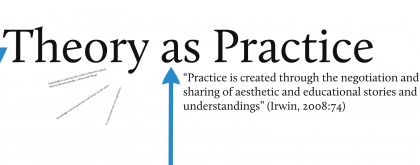
One of the first things that drew me to a/r/tography was that it insists that theory is not separate from practice, but rather that they are mutually entangled.
"Practice is created through the negotiation and sharing of aesthetic and educational stories and understandings" (Irwin, 2008:74)
So it is through process that knowledge is constructed, in the in-between spaces that lie between people, culture and things.
Knowledge is local, particular and always on the move.
And it comes from our own experience.
But our theorising is always provisional, we are never sure of ourselves, and it is this uncertainty that leads us to share our theories with others. And what we produce from this is matters of shared concern rather than matters of fact. In my current project it is the staff who document what happens when children engage with materials and objects, and this has the effect of drawing our attention to the small things, often the things that happen all the time. It is an approach that focusses on the collecting of everyday stories.
One example of this is how documentation has drawn our attention to how certain objects seem to hold a singular desire for certain children. Conflicts around snatching is an event that occurs so often that we barely think about it any more, an event that is often dealt with in stock ways using terms like sharing and taking turns. In response we have started to tune ourselves more finely into these desires and to encourage children to think about how they can resolve these conflicts themselves.
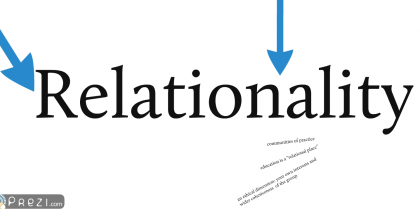
The final idea from artography that I would like to highlight is Relationality. Stephanie Springgay talks about communities of practice that form through the process of documentation.
Education is seen as a "relational place": Meanings that we give to events do not prescribe what we should do, but they point us towards many possible directions. Documentation helps us map the relationality at the heart of both our, and children’s, learning paths and processes.
While an individual practitioner may be motivated by their personal interests they are always aware that these are positioned alongside the interests of others. This involves negotiating your own personal engagement within a community of practice, so that there is always a dialogue that moves between the singular and the community.
It is through this relationship that an ethical dimension plays out, because you are always balancing your own interests and position in relation to the wider cohesiveness and interests of the group.
Stopping to linger and reflect on documentation may open up spaces for us talk about things that are often left unsaid. We are often confronted by tensions and seemingly intractable situations, and because these are difficult and often unresolvable they may become things that we feel scared to speak about: they are uncomfortable and make us feel as if we have failed. Rather than avoiding difficulty and failure, discussion can give us the confidence to proceed through a process of trail and error.
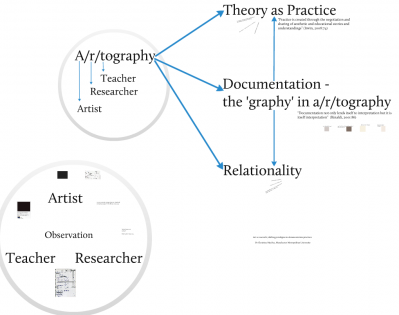
My current creative partnerships project was very short-term and I came in from the outside and do not work from inside the organisational culture of that staff group. It is rather "messy" and marginal position to work from. As a way to get support I have joined up with other artists on similar projects to form our own reflective community of practice called Threads. We are also forming a website through which we can blog and hopefully begin to reach a broader community in which to share and think about practice as we build up wider networks.
I want to finish by raising questions that both I, as well as my immediate community of practice, find keep returning to. Some of them may have tentative answers, others may perhaps indicate tensions that will always exist, and maybe ones we must continually negotiate.
Who are we? As a group of practitioners who feel as if we are trying work in a hybrid role, we are not sure what to call ourselves. We started off as seeing our selves as artists, but realised that while we borrowed many approaches from art practice we did not necessarily see ourselves as artists
How can we create reflective and open relationship with practitioners as outsiders? We are all struggling with tensions raised by working within institutions that are run strongly on organisational principles and where the relations engendered by this run deeply in the culture of the institutions. To further complicate this, in this project we are not acting as freelancers and have therefore an added organisational layer (who we are contracted to) that we are outside of and marginal to.
How do we negotiate documenting our own thoughts, feelings, and responses in a way that both stays true to ourselves, but that does not pass judgement on other people? The process of documenting seems to be very closely tied up with ethics and how we build generous and careful relations with other people, people who may not be part of our immediate community of practice. The dilemmas about how and what to document are ones that at the moment I need a lot of support from my artists group with, they are ones that we return to again and again. But making documentation the site of our relationship, and as an open space means we have to think in ethical terms as we write.
How do we make sure that our practice of documentation is sustained as part of our process and that it does not slip into a more evidential and representational modes? I struggle with my wish to keep my documentation as a product of my ongoing curiosity, and not let it become hijacked and used as evidence of learning, of creativity, and of expertise. This gets complicated as Children’s Centres and schools need to use knowledge to provide evidence of assessment. As artists (or whatever we are) we must be allowed to put process, enquiry and engagement with materials before learning outcomes during our work. We should also be careful about how we use documentation as a way to promote and evaluate our practice/projects, as once we do this the documentation is fulfilling entirely a different function.


No comments added